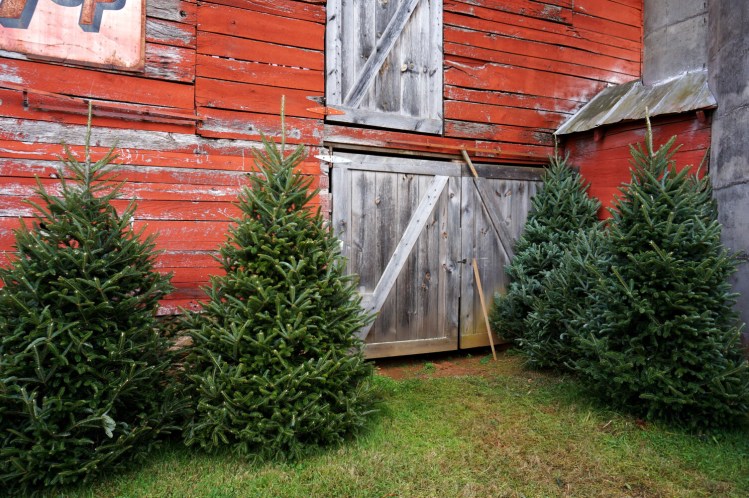Maine Christmas trees are balsam firs. Balsams are native here, so it is what the settlers brought inside when they celebrated the holiday. Decades later, the 140 or so members of the Maine Christmas Tree Growers Association still grow balsams.
But Maine, I was surprised to learn recently, is a relatively small player in the world of Christmas trees.
If you buy a Christmas tree in Maine, it likely that it was grown in-state, according to Jim Corliss of Hampden, a spokesman and two-time past president of the nonprofit Maine Christmas Tree Association. But few Maine trees are sold beyond New York and New Jersey.
The state’s largest Christmas tree grower harvests about 25,000 trees a year. Compare that to some growers in the Northwest who harvest 1 million a year, Corliss said. The Florida market is dominated by North Carolina trees, mostly Fraser firs.
Each of the two species has an advantage. For the balsam, it’s the aroma. When you bring a balsam inside – either the tree or just a few branches to use in an arrangement – it smells like Christmas (I am a native Mainer, and know the smell of a Maine Christmas). For those who can’t bring balsam trees inside, an industry exists to sell bags of balsam needles that offer the aroma without the tree.
The advantage of the Fraser is that it holds onto its needles longer – so the presents and skirting under the tree are not covered with dried-out, fallen needles.
Forty years ago, the association began work trying to develop balsams that are better able to retain their needles, Corliss said. They do this by growing and testing trees – sending some to a researcher in Washington state – and planting the seeds of specimens that proved better at holding needles. You can find a video about the research on the association’s website.

For many, the scent of Maine’s native Balsam Fir is the smell of Christmas. Sonia Horowitz/Shutterstock
In addition to having outstanding balsam fragrance and long-lasting needles, the ideal tree would also be fast-growing with excellent color and upswept branches, Corliss said.
The 2020 drought didn’t affect this year’s crop of Christmas trees, Corliss said. The trees got enough rain early in the growing season, which is when they need it most. If anything, slower growth from lack of rain later in the season would have made the branches denser. The drought probably did hurt the newly planted seedlings, however, as their roots are not fully developed. Expect to feel the impact of the 2020 drought in Christmas Yet to Come.
Now for the important stuff: What should we look for when buying a tree?
“Most people ask, ‘When was this tree cut?’” Corliss said. “But that is basically irrelevant.”
By the time a Christmas tree is cut, it’s already sent almost all of its moisture to its roots because it has gone dormant for the winter. As long as the cut trees are stored in the shade, ideally under tall pines, standing up on moist soil, they will remain in excellent shape for many weeks.
The first thing you should do when find a tree you like is to lift it and bang the base onto the ground a couple of times, Corliss said. If a lot of needles fall off, pick another tree. Look for shiny needles, too.
Before you bring your tree inside to decorate it, cut off the bottom inch or so. Immediately, put the tree into water. The tree will behave like it’s spring, Corliss said, and will want to bring water up its trunk to its needles. For the first few days, refill the well of the Christmas tree stand two or three times a day.
Corliss is not a fan of living Christmas trees – where a tree is brought inside with its roots and soil. People forget to dig a hole for the tree before the ground freezes, or if they do remember, the pile of soil needed to refill the hole when planting the tree is frozen by the time Christmas is over. Also, the tree and its soil warm up indoors, fooling the tree into thinking spring has arrived; it starts putting out buds. That new growth is killed when the tree is returned to the out-of-doors.
Wholesale growers are seeing a lot of demand this year, according to Corliss, so he advises Mainers not to wait until the last minute to buy their Christmas trees. Things probably won’t get as bad as they were with toilet paper last March, but supplies could get tight.
As with everything else, the logistics of Christmas tree-buying have been adjusted because of the pandemic. Some Christmas tree farms are offering advance ordering and touchless pickup. Be sure to call or go to the website of the farm, nursery or nonprofit where you buy your tree to understand the coronavirus safety rules before heading out.
And enjoy that heady balsam fragrance.
Tom Atwell is a freelance writer gardening in Cape Elizabeth. He can be contacted at: tomatwell@me.com.
Send questions/comments to the editors.



Comments are no longer available on this story